Photo: Nicolae Stoian
When asked on MLSsoccer.com’s Extratime podcast what he thought when Peter Nowak introduced the five man backline to the team, Danny Califf said, “To be honest, you know, I was a bit surprised. Most of the time, come playoff time, it’s not the time to be experimenting and trying out new things and new personnel and things like that. Especially since we had been, you know, pretty successful, I think, especially on the defensive end throughout the course of the year. So I was a bit surprised.”
Asked about how much time the team had to train with the new system, Califf replied, “We trained, like, the last two or three days, kind of, on it. Not really the last day because it was a blizzard. So we trained a couple of days to try and sort things out. But the way it turned out, it looked like we should have trained a few more days.”
Califf was then asked if the reasoning behind the new system had been explained to the team.
“Yeah, well, I mean, Peter explained it his way,” Califf said. “But I don’t know whether, you know, there was a clear cut definition as to the real reason. I think he was trying to get Gabriel Farfan and Sheanon Williams a little bit higher on the attack but he was also, I think, trying to get some more numbers in the box to deal with their crosses and things like that.”
Nowak said as much after Sunday’s loss to Houston Dynamo in the first leg of the Eastern Conference Semifinal, when he explained in the post-game press conference that the intent behind the never-before-seen five man backline employed by the Philadelphia Union was “to avoid those penetrating runs.” He continued, “We decided to [play with 5 defenders] not just from a defensive standpoint, but from an offensive standpoint as well. We could push (our fullbacks) up further on the wings.”
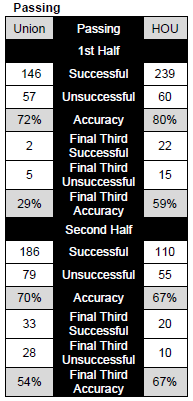 Stefani Miglioranzi said of the formation after the game, “All in all, I think it worked out pretty well. Maybe in the second goal, there was a hint of offsides that caught us on a break and then it was a trademark set piece for the first one.”
Stefani Miglioranzi said of the formation after the game, “All in all, I think it worked out pretty well. Maybe in the second goal, there was a hint of offsides that caught us on a break and then it was a trademark set piece for the first one.”
Putting aside the fact that Miglioranzi was supposed to be marking Andre Hainault on the first goal—whose free header was the result of both Houston’s first free kick and first cross of the game—the second goal resulted from exactly the kind of penetrating run the new defensive formation was supposed to prevent, with Calen Carr moving behind the defense to receive Brian Ching’s ball between Garfan and Miglioranzi. Rather than working pretty well, most would agree the new formation worked pretty poorly. Was Carr offside? All that matters is that the ref pointed to the center circle at the end of the play.
If the five man backline was a failure defensively, did the transition to a three man backline with Garfan and Williams pushing up when the team transitioned forward help the Union offensively? It didn’t seem to in terms of scoring goals. Sebastien Le Toux’s goal did not result from wing play. Carlos Valdes had attempted a long pass to Danny Mwanga that was nearly turned over. Justin Mapp recovered the ball and, cutting inside, passed to Michael Farfan. Marfan’s delivery into the box was deflected off of a Houston defender, fortuitously dropping to the feet of the absolutely in top form Le Toux, who made no mistake with what could have been a tricky finish.
As we will see below, the Union’s offensive numbers actually improved once the experimental lineup was, thankfully, and one hopes permanently, consigned to the dustbin of history.
Passing
Looking at the Union’s passing numbers, while overall accuracy slightly decreased, in terms of quantity, the Union did better after they dropped the five man backline and returned to the four man line they had used all year, going from 146 successful passes in the first half to 186 successful passes in the second half. This is glaringly apparent in the final third: in the first half, the Union had two successful passes out of seven attempted passes in the entire first half . In the second half, those numbers increased to 33 successful passes out of 61 attempted passes. Looking at accuracy in the final third of the field, the Union’s accuracy nearly doubled from 29 percent to 54 percent. In comparison, Houston successfully connected 22 passes out of 37 attempted in the final third during the first half. The number of successful passes dropped slightly to 20 in the second half from 30 attempted passes, but Houston’s passing accuracy improved from 59 percent to 67 percent. If they had been able to finish their chances better, they could have buried the Union in a much deeper hole than the one they find themselves in now.
Mondragon’s distribution 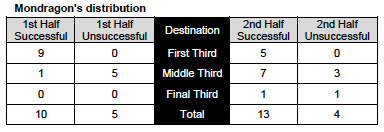
Mondragon’s distribution from the back has become more noticeable since his return to the starting lineup, if only because the MacMath’s booming kicks were something of a revelation. While Mondragon’s overall accuracy in the first half came in at 67 percent, his kicks into the middle third—from goal kicks, punts from saves, free kicks from offsides calls, and so on, most of which end in the opposition’s half of the field—came in at a paltry 17 percent with only one successful delivery to a Union player from six attempts. Mondragon’s numbers improved in the second half with his overall accuracy rising to 76 percent. More importantly, his kicks to the middle third of the field improved to 70 percent, with seven successful completions from ten attempts. Not only is such a high rate important in terms of maintaining possession, but such accuracy is essential if the Union is to be successful in creating quick counterattacking opportunities.
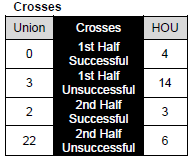 Crosses
Crosses
It was well known going into Sunday’s game that Houston are very good at creating opportunities from crosses, be they from open play or set pieces. As was mentioned above, the Dynamo converted on their first cross of the game, a cross that came from a Brad Davis free kick. Houston would record five key passes in the first half and two would come from crosses. Overall, their succesrate with crosses in the first half was 22 percent. In the second half, during which Houston recorded 1 key pass from a cross, their success rate improved to 27 percent.
The Union had three crosses in the first half, none of which were successful. The Union greatly increased the tempo of attempted crosses in the second half from three in the first half to 24. Only two crosses found their target for a successful completion rate of eight percent, although both were key passes.
Offensive stats 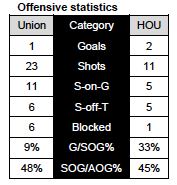
The Union doubled the Dynamo’s number of attempts on goal—and nearly doubled the number of shots on goal—and their shots on goal from shots attempted percentage of 48 percent was greater than Houston’s 45 percent. The Union’s goals/shots on goal percentage of 9 percent was less than Houston’s 33 percent.
While the Union created more chances overall than Houston, it can be argued that they actually created fewer quality chances. Of the 23 attempts on goal recorded by the Union, 15 were shots from outside of the penalty area. That is 65 percent. In comparison, only two of Houston’s 11 attempts on goal, or 18 percent, came from outside of the penalty area. While neither team recorded any shots from inside the goal area, the Dynamo recorded four shots on goal from inside the penalty area compared to the Union’s three.
More specifically, only 27 percent of the Union’s shots on goal came from inside the penalty area. That means 73 percent came from distance, outside of the penalty area. In comparison, 80 percent of Houston’s shots on target came from inside the penalty area with only 20 percent from distance.

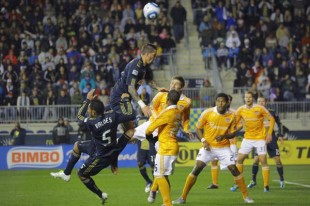

Like I said before, the Union can’t shoot, except for Letoux; just look at their shooting drills and these statistics.
Would have liked to have seen # of headers. Think Houston must have had 80% of them.
I agree with the header aspect. This team does not have a single player that is capable of delivering consistent and accurate headers. None. But, I am wondering if the shooting comes down to the system employed and not the players themselves. The only offensive option is pass to Le Toux, that’s it. No other variation in attack. Occasionally you see someone make a run by themselves without passing, but that usually ends in a poor shot or losing possession (Can anyone guess the player I’m talking about? Hint: He’s balding and over paid). I said before the season started that we needed to sign another top quality striker who compliments Le Toux (i.e. NOT Carlos Ruiz) and I still think that should be one of the top priorities this off season. Mwanga looks horrible and seemingly void of the confidence he displayed last season and for all the praise heaped on JacMac his off the ball play just is not developed yet. I am guessing that the JacMac comment is going to generate heat so I’ll point to the free kick situations/corners in the Houston game. Watch what he does before the kicks. He zig zags around the box like a mad man, which means that it is impossible to target him with a free kick (if anyone on our team was that accurate). The difference between the Union and Houston on set pieces is that the Houston players make logical and specific runs that make it so Brad Davis can target specific players that he wants to deliver the ball to, but with us we essentially just dump the ball into a zone and hope that someone gets a head to it.
Haha you were right, here is my attempt to defend Union Jack. I think his off the ball movement is something he is good at, or atleast provides better than other options. For example, his one piercing run that led to him getting tackled by the Guido Houston player and getting chewed out. What a great run. I didn’t see a single similar run from a Union player all night.
If we play the ball on the ground, which is obviously our strength, I think Union Jack would make good runs and would be a good striker in our system.
Taking total headers for both teams:
Of successfully headed passes, the Union had 42% (15 of 36) and Houston had 58% (21 of 36)
Of headed shots on target, the Union had 25% (1 of 4) and Houston had 75% (3 of 4)
Breakdown by half:
1ST HALF:
Union – 15 headed passes (7 successful, 8 unsuccessful)
0 headed shots on target, 0 headed shots off target
HOU – 18 headed passes (8 successful, 10 unsuccessful)
3 headed shots on target, 2 headed shots off target, 1 headed goal
2ND HALF:
Union – 24 headed passes (12 successful, 12 unsuccessful)
1 headed shot on target, 2 headed shots off target
HOU – 15 headed passes (9 successful, 6 unsuccessful)
0 headed shots on target, 1 headed shot off target
TOTALS:
Union: 39 headed passes, 19 successful, 20 unsuccessful
(49% successful headed passes)
1 headed shot on target, 2 headed shots off target
(33% HSOG/AHS)
HOU: 33 headed passes, 17 successful, 16 unsuccessful
(52% successful headed passes)
3 headed shots on target, 3 headed shots off target, 1 headed goal
(50% HSOG/AHS, 33% HG/HSOG)
It was a 3-5-2 not a 5 man back line.
It was a 3-5-2 on offense, with two fullbacks (Williams & Garfan) playing as wingbacks. On defense, it was a five-man back line.
yes that’s exactly how a traditional 3-5-2 works. wing backs drop to create 5 man back line when possession is lost.
Yep. We’re talking about the same thing. It’s semantics what you call it. I called it a five-man back line in my post (the open letter post) because that’s what the Union called it. But you could even argue it’s still a four-man back line, with Migs just dropping deep from midfield like Busquets does in Spain and the fullbacks pushing up.
Thats what I saw…I remember saying “what is Williams doing playing left wing” at one point during the 1st half…
The Nowak quote is from an article on the Union website that refers to a five-man backline or 5-3-2 five times, not including the title of the article, which is “Union five-man back line deceptively attack-minded”. I’m therefore assuming it has some authority but, of course, everyone is correct – 5 men defensively, three men offensively. Williams says in the article, “It was more of three in the back with me and Gabe pushing up almost as midfielders, but obviously we’ve got our defensive responsibilities.” (If memory serves, Williams pushing up inside as well as on the wings was also particularly noticeable in the second half against New York and, I think to a lesser degree, against Toronto.)
In the end, do we all agree that the new formation was a failure?
“All in all, I think it worked out pretty well.” ha, he can’t even comment well. thursday he’ll probably give nowak’s press conference too.
I think Califf’s gonna learn real fast that you don’t question the gaffer … ever. Not only will he not get the start on Thursday, but we’ve seen the last of him in a Union shirt. 😉
» Were listed on ALLTOP!, here i have found the information i need, so thanks for your help and keep on the good work, Schoenheit